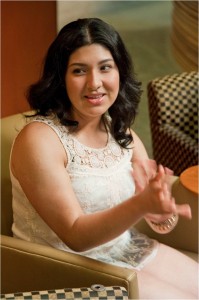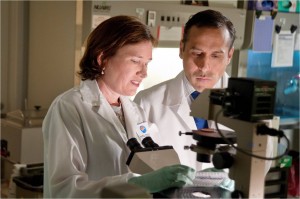
Kathia Vega Flores will never forget the way her friends and family reacted when she came home from a month-long hospital stay at age 11: They did not recognize her.
Kathia had been diagnosed with lupus, a lifelong disease that causes inflammation throughout the body. The medications used to control her disease caused Kathia’s body to swell. She couldn’t walk without assistance. She was often dizzy and nauseous. In total, Kathia was taking 20 pills each day.
“The medications changed me a lot,” she said. “It was very hard. I just wanted to get back to my normal routine of going to school and seeing my family without upsetting them.”
Lupus is most commonly diagnosed in teenage girls, but half of a million people in the United States are living with it. The disease can lead to rashes, fevers, enlarged lymph nodes, psychoses, seizures and inflammation of the heart, lungs or brain.
Roadblocks on the road to cures
Dr. Anne Stevens, a research expert at Seattle Children’s Research Institute, has been treating lupus patients at Seattle Children’s for 25 years. Despite the great advances experts like her have made studying the immune system, lupus is still treated with toxic medications like chemotherapy and steroids because of a lack of funding for pediatric research.
“Lupus can be deadly,” she said. “To save these children and protect their organs, we are forced to use very harmful medications that suppress their immune systems for the rest of their lives. We could do a lot better if we found new treatment options.”

Developing drugs for any pediatric disease is difficult because funding is limited. There have never been any treatment trials for pediatric lupus or for any medications to treat the resulting inflammation, Stevens said.
“We need to study medications specifically for children to be able to accurately dose and safely treat this age group,” Stevens said. “Children are not just little adults. We can’t just cut a dose in half. They process medications differently than adults.”
New hope for better treatments
A new collaboration between Seattle Children’s Research Institute and biotechnology company Kineta, called the Alliance for Children’s Therapeutics, is designed to accelerate the development of new medications for children with autoimmune diseases, like lupus, by combining philanthropic support and equity investments.
The first treatment brought forth by the Alliance is ShK-186, a medication developed from sea anemone venom. ShK-186 deactivates certain white blood cells that cause problems in patients with lupus while leaving the rest of the immune system in tact. The result: far fewer side effects.

“This could completely change how we treat patients with lupus,” Stevens said. “Instead of toxic medications and frequent hospitalizations, we could treat patients with one shot a week and avoid clobbering the whole immune system. These kids would be back in school, living their lives.”
ShK-186 has already been proven effective in animal models. Next, Seattle Children’s Research Institute plans to study the drug in patients. If it is successful, Kineta will bring ShK-186 to market so that it is widely available to patients.
“Alliance for Children’s Therapeutics is going to move this project forward very quickly,” Stevens said. “We hope within a year we’ll have enough evidence to initiate a clinical research study to test this in patients. There’s no way that could happen without this collaboration.”
Kathia is now 18 years old and has learned to manage her disease, and her medications, with the help of Seattle Children’s clinicians. Still, she hopes research will make life easier in the future.
“There is a huge need for medications designed for children and teens,” Kathia said. “A diagnosis of lupus can present daily challenges not only for the person with the disease, but the whole family. I am so encouraged to see ongoing research and possible new treatments for lupus and other autoimmune diseases that will help so many children in need of better medications and care options.”
For more information on the Alliance for Children’s Therapeutics, please watch our video below.
Media who are interested in interviewing Dr. Anne Stevens should contact Seattle Children’s PR team at 206-987-4500 or at [email protected]. Our press release is also available online.
For more images, please visit our Flickr album.
Resources
- Seattle Children’s Rheumatology Program
- Seattle Children’s Research Institute
- Kineta

